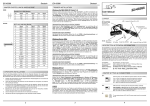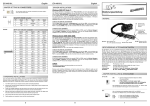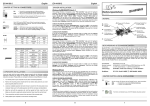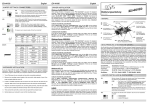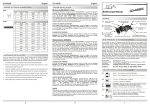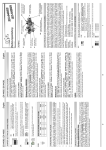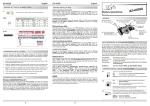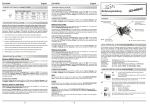Download EXSYS EX-41016
Transcript
EX EX--41016 English JUMPER SETTING & CONNECTORS: J3: DB9M: 1 +5V 2 GND 3 GND 4 +12V English DRIVER INSTALLATION : Windows 9x/ME/2000/XP & Vista: To use external power (JP4) the PC power supply must be connected to J3! Serial 9 Pin male connector: Pin HPC68F: EX EX--41016 Signal 1 CDC 2 3 Pin Signal 4 DTR RXD 5 TXD 6 Pin Signal 7 RTS GND 8 CTS DSR 9 RI 68 Pin mini half pitch connector : After starting Windows it recognizes a new “PCI Controller“ and opens the hardware assistant. Please choose manual installation and put the driver CD into your CD-Rom drive. Now enter the Path "D:\IO\OXFORD\" and then the directory of your operating system “95_98_ME“ “2000“ “XP32“ “XP64“ “Vista32“ or “Vista64“ into the box for the Path/Source and click at >next/continue<. Now Windows searches for the drivers in the specified directory. Follow the hardware assistant and finish the installation. If Windows recognizes other new devices repeat the above described steps. Attention! Restart Windows in any case after installing the drivers. Signal Pin Signal Pin Signal DCD 1 24 DSR 3 47 RTS 6 CHANGE PORT NUMBER: 2 RXD 1 25 RTS 3 48 CTS 6 3 TXD 1 26 CTS 3 49 GND 4 DTR 1 27 DCD 4 50 DCD 7 If you like to change the port number for example COM 3 to COM5, open the >Device Manager< click at >COM3<, >Settings< and then >Advance<. There you can choose between COM 3 to 256. 5 DSR 1 28 RXD 4 51 RXD 7 Windows Server 2000/2003/2008: 6 RTS 1 29 TXD 4 52 TXD 7 7 CTS 1 30 DTR 4 53 DTR 7 8 DCD 2 31 DSR 4 54 GND 9 RXD 2 32 RTS 4 55 DSR 7 10 TXD 2 33 CTS 4 56 GND After starting Windows it recognizes a new “PCI Controller“ and opens the hardware assistant. Please choose manual installation and put the driver CD into your CD-Rom drive. Now enter the Path "D:\IO\OXFORD\" and then the directory of your operating system for Server 2000: “2000“ for Server 2003: “XP32“ or “XP64“ and for Server 2008 “Vista32“ or “Vista64“ into the box for the Path/Source and click at >next/ continue<. Now Windows searches for the drivers in the specified directory. Follow the hardware assistant and finish the installation. If Windows recognizes other new devices repeat the above described steps. Attention! Restart Windows in any case after installing the drivers. DTR 2 34 NC 57 RTS 7 DSR 2 35 DCD 5 58 CTS 7 13 RTS 2 36 RXD 5 59 GND 14 CTS 2 37 TXD 5 60 DCD 8 15 GND 38 DTR 5 61 RXD 8 16 DCD 3 39 DSR 5 62 GND 17 CN_PWR 40 RTS 5 63 TXD 8 18 CN_PWR 41 CTS 5 64 DTR 8 19 RXD 3 42 DCD 6 65 DSR 8 20 GND 43 RXD 6 66 RTS 8 21 TXD 3 44 TXD 6 67 CTS 8 22 GND 45 DTR 6 68 NC 23 DTR 3 46 DSR 6 HARDWARE INSTALLATION : If you are ready with the jumper settings, please proceed with the following installation instructions. Because the designs of computers are different, only general installation instructions are given. Please refer your computer’s reference manual whenever in doubt. 1. Turn off the power to your computer and any other connected peripherals. 3. Locate an available expansion slot and remove its covers from the rear panel of your computer. Make sure it is the right expansion slot for the card (see card description) 4. Align the card with the expansion slot, and then gently but firmly, insert the card. Make sure the card is seated and oriented correctly. Never insert the card by force! 5. Then connect the card with a screw to the rear panel of the computer case. 6. Gently replace your computer’s cover and the mounting screws. 5 JP4 Jumper für Power auf PIN59 CHECK THE INSTALLED DRIVER: Click at >Start< >Run< then enter “compmgmt.msc“ and click at >OK<. In the windows that opens select >Device Manager<. Under „Ports (COM and LPT)“ you should find a new „PCI Port“ as sample (Com3). If you see this or similar entries the card is installed correctly. CHANGE PORT NUMBER: If you like to change the port number for example COM 3 to COM5, open the >Device Manager< click at >COM3<, >Settings< and then >Advance<. There you can choose between COM 3 to 256. Windows NT 4.0: Start Windows NT and insert the driver CD into your CD-ROM drive (for example D:). Click at >Start< >Run< and enter „D:\IO\OXFORD\NT4\Install_Serial.exe" then click >OK<. Windows NT will now start the setup program and install the driver. Please Restart Windows NT after installing the drivers. S1- S16 68 Pin Buchse für Octopus Kabel mit 8 x 9 Pin Seriell Anschluss Jumper für Power 5V oder 12V J3 Seriell Chip 16C550 Anschluss für PCNetzteil BESCHREIBUNG & TECHNISCHE DATEN : Die EX-41016 ist eine PCI serielle RS-232 Karte mit 16 seriellen FIFO 16C550 Ports, für den Anschluss von High-Speed parallelen und seriellen RS-232 Peripherie Geräten (z.B. Terminal, Modem, Drucker, Plotter usw.). Sie besitzt zwei 16C550 Chipsets mit 32byte FIFO Cache. Die Karte gewährleistet so eine sichere Datenübertragung und exzellente Performance von bis zu 115,2KBaud/s für jedes angeschlossene serielle Gerät! Sie unterstützt alle PCI & PCI-X Slots mit 3.3V und 5Volt. Es ist nicht möglich die I/O Adressen und Interrupts manuell einzustellen, da die Einstellungen der Karte vom System (BIOS) und beim Installieren des Betriebssystems automatisch vorgenommen werden. Mit dem Jumper JP4 können Sie die Stromversorgung der Karte und Endgeräte wählen. Beachten Sie bitte das Anschluss J3 im fall der externen Stromversorgung ( z.B. X12V) mit dem PC-Netzteil verbunden werden muss! Achtung! JP2 kann nur auf PWR gesetzt werden wenn ein spezielles Kabel verwendet wird welches sich nicht im Lieferumfang befindet! Es wird ausschließlich zur Versorgung von Endgeräten benötigt. Kompatibilität: Betriebs Systeme: Anschlüsse: Lieferumfang: PCI & PCI-X, 5Volt oder 3,3Volt 9x/ME/NT 4.0/2000/XP/Server 2003,2008/Vista (Linux vom OS) 16 x 9 Pin Seriell Sub-D Stecker EX-41016, Treiber CD, Anleitung, 2 x Octopus Kabel 8 x 9 Pin Zertifikate: CE / FCC / RoHS / WEEE DE97424562 / WHQL CHECK THE INSTALLED DRIVER: Click at >Start< >Programs< >Administrative Tools[Common]< >Windows NTDiagnostics< then click at >Resource< >IRQ<. Here you should find the entry „09 oxser 0 PCI“. Then click at >I/O-Port< here you should see the entries „D400-D407 oxser 0 PCI“ „D800-D802 oxser 0 PCI“ and „DC00-DC1F oxser 0 PCI“ for the ports. The I/O addresses can change depends which system and card is installed. If you see these or similar entry's the card is installed correctly. JUMPER EINSTELLUNG & ANSCHLÜSSE: (Nur in Verbindung mit speziellem Kabel & JP2 auf PWR!!!) JP4: I12V X12V X5V I5V 2. Remove the mounting screws located at the rear and/or sides panels of your Computer and gently slide the cover off. AUFBAU : JP2 Click at >Start< >Run< then enter “compmgmt.msc“ and click at >OK<. In the windows that opens select >Device Manager<. Under „Ports (COM and LPT)“ you should find a new „PCI Port“ as sample (Com3). If you see this or similar entries the card is installed correctly. 1 12 Vers. 1.0 / 25.06.09 CHECK THE INSTALLED DRIVER: Pin 11 Bedienungsanleitung LINUX: There are no drivers available for Linux, but the card is supported by the most versions of Linux. Because each individual distribution and kernel version of Linux is different, sadly we cant provide a installation instruction. Please refer to the installation manual for standard IO ports from your Linux version! In some newer versions the card will even be installed automatically after starting Linux. 6 JP2& JP3: DIS | PWR I12V = Strom auf PIN59 mit 12Volt vom Mainboard (STANDARD) X12V = Strom auf PIN59 mit 12Volt vom PC-Netzteil X5V = Strom auf PIN59 mit 5Volt vom PC-Netzteil I5V = Strom auf PIN59 mit 5Volt vom Mainboard DIS (Masse) = Achtung! Jumper nicht verändern! (STANDARD) PWR (POWER) = Achtung! Jumper nicht auf diese Einstellung setzen! Karte, PC und Endgeräte könnten beschädigt werden! Verwendung nur mit optionalem speziellem Kabel !!! 1 EX EX--41016 Deutsch JUMPER EINSTELLUNG & ANSCHLÜSSE: DB9M: HPC68F: Deutsch TREIBER INSTALLATION : Windows 9x/ME/2000/XP & Vista: Für externe Stromversorgung (JP4) muss J3 mit dem PC Netzteil verbunden werden! Seriell 9 Pin SUB-D Stecker : Pin Signal Pin Signal Pin Signal 1 CDC 4 DTR 7 RTS 2 RXD 5 GND 8 CTS 3 TXD 6 DSR 9 RI Windows erkennt beim Start einen neuen “PCI Controller“ und öffnet automatisch den Windows Hardwareassistenten. Wählen sie die manuelle Installation aus und legen Sie die Treiber CD in Ihr CD-ROM Laufwerk (z.B. Laufwerk D:). Geben sie nun den Pfad "D:\IO\OXFORD\" und dann das Verzeichnis ihres Betriebssystems “95_98_ME“ “2000“ “XP32“ “XP64“ “Vista32“ oder “Vista64“ in das jeweilige Feld für die Quelle/ Pfad ein und klicken sie auf >weiter<. Windows sucht nun nach den Treibern in dem angegebenen Verzeichnis. Folgen sie den Anweisungen des Hardwareassistenten und beenden sie die Installation. Sollte Windows noch weitere neue Hardware erkennen wiederholen sie die oben angegebenen Schritte. Wichtig! Starten Sie Windows in jedem Fall nach der Installation neu. Vers. 1.0 / 25.06.09 LAYOUT : JP2 JP4 Jumper for Power on PIN59 Jumper for Power 5V or 12V ÜBERPRÜFEN DER INSTALLIERTEN TREIBER: 68 Pin mini half pitch Stecker: Pin Signal Pin Signal Pin Signal 1 DCD 1 24 DSR 3 47 RTS 6 2 RXD 1 25 RTS 3 48 CTS 6 3 TXD 1 26 CTS 3 49 GND 4 DTR 1 27 DCD 4 50 DCD 7 5 DSR 1 28 RXD 4 51 RXD 7 6 RTS 1 29 TXD 4 52 TXD 7 7 CTS 1 30 DTR 4 53 DTR 7 8 DCD 2 31 DSR 4 54 GND DSR 7 Klicken Sie auf >Start< >Ausführen< geben sie “compmgmt.msc“ ein und klicken sie auf >OK<. Wählen sie nun >GeräteManager<. Dort müssten sie unter „Anschlüsse (COM und LPT)“ einen neuen „PCI Port“ z.B. (Com3) sehen. Wenn sie diese oder ähnliche Einträge sehen, ist die Karte korrekt installiert. ÄNDERN DER PORT NUMMER: Hier können sie die Ports ändern, klicken sie z.B. auf >COM3< >Anschlusseinstellung< und >Erweitert<. Sie können dann zwischen Com3 und 256 wählen. Windows Server 2000/2003/2008: Windows erkennt beim Start einen neuen “PCI Controller“ und öffnet automatisch den Windows Hardwareassistenten. Wählen sie die manuelle Installation aus und legen Sie die Treiber CD in Ihr CD-ROM Laufwerk (z.B. Laufwerk D:). Geben sie nun den Pfad "D:\IO\OXFORD\" und dann das Verzeichnis ihres Betriebssystems für Server 2000: “2000“ für Server 2003: “XP32“ oder “XP64“ und für Server 2008 “Vista32“ oder “Vista64“ in das jeweilige Feld für die Quelle/Pfad ein und klicken sie auf >weiter<. Windows sucht nun nach den Treibern in dem angegebenen Verzeichnis. Folgen sie den Anweisungen des Hardwareassistenten und beenden sie die Installation. Sollte Windows noch weitere neue Hardware erkennen wiederholen sie die oben angegebenen Schritte. Wichtig! Starten Sie Windows in jedem Fall nach der Installation neu. 9 RXD 2 32 RTS 4 55 10 TXD 2 33 CTS 4 56 GND 11 DTR 2 34 NC 57 RTS 7 12 DSR 2 35 DCD 5 58 CTS 7 13 RTS 2 36 RXD 5 59 GND 14 CTS 2 37 TXD 5 60 DCD 8 15 GND 38 DTR 5 61 RXD 8 16 DCD 3 39 DSR 5 62 GND ÜBERPRÜFEN DER INSTALLIERTEN TREIBER: 17 CN_PWR 40 RTS 5 63 TXD 8 18 CN_PWR 41 CTS 5 64 DTR 8 19 RXD 3 42 DCD 6 65 DSR 8 20 GND 43 RXD 6 66 RTS 8 Klicken Sie auf >Start< >Ausführen< geben sie “compmgmt.msc“ ein und klicken sie auf >OK<. Wählen sie nun >GeräteManager<. Dort müssten sie unter „Anschlüsse (COM und LPT)“ einen neuen „PCI Port“ z.B. (Com3) sehen. Wenn sie diese oder ähnliche Einträge sehen, ist die Karte korrekt installiert. 21 TXD 3 44 TXD 6 67 CTS 8 22 GND 45 DTR 6 68 NC 23 DTR 3 46 DSR 6 HARDWARE INSTALLATION : Wenn Sie die Karte installieren, beachten Sie bitte die folgenden Hinweise. Da es grosse Unterschiede bei Computern gibt, können wir Ihnen nur eine generelle Anleitung zum Einbau geben. Bei Unklarheiten halten Sie sich bitte an die Bedienungsanleitung Ihres Computersystems. 1. Schalten Sie Ihren Rechner und alle angeschlossenen Peripheriegeräte aus und ziehen Sie bei allen Geräten den Netzstecker. 2. Lösen Sie die Schrauben des Gehäuses auf der Rückseite Ihres Computers und entfernen Sie vorsichtig das Gehäuse. 3. Suchen Sie einen freien Steckplatz und entfernen sie das Slotblech, stecken Sie die Karte vorsichtig in den ausgewählten Steckplatz ein. Stellen sie sicher das es sich um den richtigen Steckplatz handelt! (siehe Kompatibilität unter technische Daten) 4. Beachten Sie, das die Karte korrekt eingesteckt wird und das kein Kurzschluss entsteht. Wenden sie keine Gewalt an um die Karte einzustecken! 5. Danach befestigen Sie die Karte bitte mit einer Schraube am Gehäuse. 6. Jetzt können das Computergehäuse mit den Schrauben wieder schliessen. 2 User Manual ÄNDERN DER PORT NUMMER: Hier können sie die Ports ändern, klicken sie z.B. auf >COM3< >Anschlusseinstellung< und >Erweitert<. Sie können dann zwischen Com3 und 256 wählen! Windows NT 4.0: Starten Sie Windows NT 4.0 und legen Sie die Treiber CD in Ihr CD-ROM Laufwerk (z.B. Laufwerk D:) und klicken auf >Start< >Ausführen< und geben Sie „D:\IO\OXFORD\NT4\Install_Serial.exe" ein. Windows NT 4.0 startet das Setup Programm und installiert den Treiber. Starten Sie Windows NT jetzt neu. ÜBERPRÜFEN DER INSTALLIERTEN TREIBER: Klicken Sie auf >Start<>Programme<>Verwaltung(Allgemein)<>Windows NTDiagnose< danach klicken Sie auf >Ressourcen<>IRQ<. Hier werden Sie einen Eintrag z.B. „09 oxser 0 PCI“ für die Karte finden. Klicken Sie jetzt auf >I/O-Port<. Hier müssten Sie vier Einträge: z.B. „D400-D407 oxser 0 PCI“ oder „D800-D802 oxser 0 PCI“ und „DC00-DC1F oxser 0 PCI“ finden. Die I/O Adressen können sich ändern. Sollten Sie ähnliche Einträge sehen, ist die Karte korrekt installiert. S1- S16 68 Pin connector for octopus cable with 8 x 9 pin serial connector 3 Connector for PCpower supply The EX-41016 is a plug & play high-speed serial RS-232 expansion card for the PCI Bus. The EX-41016 provides eight 9 pin high speed RS-232 serial ports. It uses data transfer rates up to 115.2Kbaud/s. The EX-41016 design utilizes the 16C550 UART with 32byte buffer, which incorporates the latest in high speed interface technology. It supports motherboards with 32- and 64-Bit Bus and 5- and 3.3Volt PCI-bus power. It is not possible to change the address or IRQ settings manually because they will be obtained automatically by the system BIOS and operating system. With the jumper JP4 you can set the power for the card and peripheral devices. Please note if you use external power J3 have to be connected to the PC power supply. Warning! The power for peripheral devices (JP2) can only be set to power if you use an additional special cable which is not included in the delivery. It is used only to supply your serial devices with power over the serial Pin 59 (GND)! Compatibility: Operating system: Connections: Extent of delivery: PCI and PCI-X, 5 Volt or 3.3 Volt 9x/ME/NT 4.0/2000/XP/Server 2003/2008/Vista/(Linux by OS) 16 x 9 pin D-SUB serial male connector EX-41016, Driver CD, Manual, 2 xOctopus cable with 8 x 9 pin Certificates: CE / FCC / RoHS / WEEE DE97424562 / WHQL JUMPER SETTING & CONNECTORS: JP4: LINUX: Es gibt für diese Karte keine Linux Treiber, sie wird allerdings unter den meisten Linux Versionen unterstützt. Da sich die einzelnen Distributionen und Kernelversionen sehr von einander unterscheiden können wir ihnen leider hier keine Installationsanweisung geben. Bitte halten sie sich an die Installationsanweisung für Standard IO Ports ihrer Linux Version. In einigen Versionen wird die Karte automatisch beim Start Installiert. J3 Serial Chip 16C550 DESCRIPTION & TECNICAL INFORMATION : I12V X12V X5V I5V 1 +5V 2 GND 3 GND 4 +12V J3: EX EX--41016 JP2& JP3: DIS | PWR (Warning! Only use with additional optional cable & JP2 set to PWR!!!) I12V = Power on PIN59 with 12Volt from Mainboard (default) X12V = Strom on PIN59 with 12Volt from PC-power supply X5V = Strom on PIN59 with 5Volt from PC-power supply I5V = Strom on PIN59 with 5Volt from Mainboard DIS (Ground) = Warning! Do not change this setting! (default) PWR (POWER) = Warning! Do not use this setting, it can destroy your hardware! Card, PC and pheriperal devices could be damaged! Use only with special optional Cable !!! 4
This document in other languages
- Deutsch: EXSYS EX-41016


